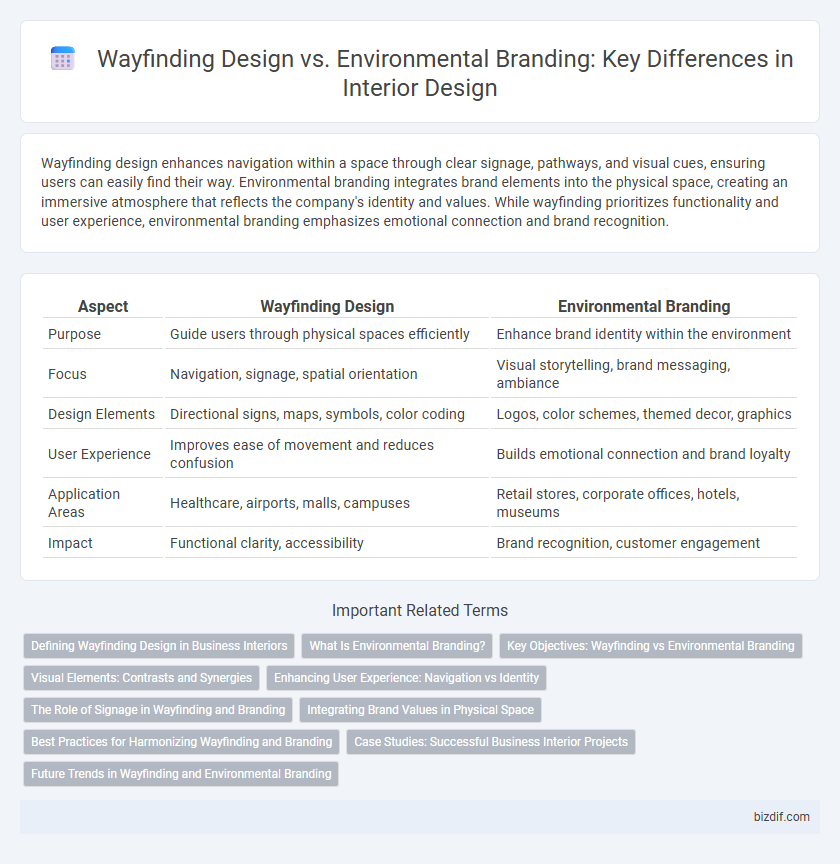Wayfinding design enhances navigation within a space through clear signage, pathways, and visual cues, ensuring users can easily find their way. Environmental branding integrates brand elements into the physical space, creating an immersive atmosphere that reflects the company's identity and values. While wayfinding prioritizes functionality and user experience, environmental branding emphasizes emotional connection and brand recognition.
Table of Comparison
| Aspect | Wayfinding Design | Environmental Branding |
|---|---|---|
| Purpose | Guide users through physical spaces efficiently | Enhance brand identity within the environment |
| Focus | Navigation, signage, spatial orientation | Visual storytelling, brand messaging, ambiance |
| Design Elements | Directional signs, maps, symbols, color coding | Logos, color schemes, themed decor, graphics |
| User Experience | Improves ease of movement and reduces confusion | Builds emotional connection and brand loyalty |
| Application Areas | Healthcare, airports, malls, campuses | Retail stores, corporate offices, hotels, museums |
| Impact | Functional clarity, accessibility | Brand recognition, customer engagement |
Defining Wayfinding Design in Business Interiors
Wayfinding design in business interiors focuses on creating intuitive navigation systems that help employees and visitors efficiently locate key areas such as offices, meeting rooms, and amenities. It integrates visual cues like signage, color-coded pathways, and spatial organization to reduce confusion and enhance user experience. Unlike environmental branding, which emphasizes corporate identity expression through decor and materials, wayfinding prioritizes functionality and clarity in spatial orientation.
What Is Environmental Branding?
Environmental branding integrates visual identity into physical spaces to create immersive brand experiences that enhance customer perception and engagement. Unlike wayfinding design, which primarily focuses on guiding people efficiently through spaces using signage and directional cues, environmental branding encompasses aesthetics, materials, colors, and spatial elements that evoke brand values and emotional connections. This approach strengthens brand presence within interior environments by transforming spaces into authentic representations of a company's ethos and identity.
Key Objectives: Wayfinding vs Environmental Branding
Wayfinding design focuses on optimizing spatial navigation by using clear signage, landmarks, and visual cues to enhance user orientation and reduce confusion within interior environments. Environmental branding integrates graphic elements, colors, and materials to create a cohesive brand experience that reflects the identity and values of a company throughout the physical space. Key objectives of wayfinding prioritize functional clarity and user efficiency, while environmental branding emphasizes emotional connection and brand recognition.
Visual Elements: Contrasts and Synergies
Wayfinding design uses visual elements like color contrast, typography, and symbols to create clear, navigable pathways within interior spaces, ensuring user orientation and functional clarity. Environmental branding integrates logos, color schemes, and textures to embed a brand's identity seamlessly into the physical environment, enhancing emotional connection and recognition. Combining wayfinding with environmental branding leverages contrasts in visual hierarchy while synergizing brand aesthetics, resulting in cohesive, intuitive spaces that guide visitors and reinforce brand presence simultaneously.
Enhancing User Experience: Navigation vs Identity
Wayfinding design focuses on enhancing user experience by simplifying navigation through clear signage, intuitive layouts, and visual cues that help users effortlessly find their way within a space. Environmental branding emphasizes creating a strong sense of identity by integrating brand elements, colors, and materials into the interior design, reinforcing brand recognition and emotional connection. Both strategies complement each other by improving spatial orientation while simultaneously communicating the brand's personality and values.
The Role of Signage in Wayfinding and Branding
Signage plays a crucial role in wayfinding by providing clear, legible visual cues that guide users through complex interior spaces, improving navigation and user experience. In environmental branding, signage integrates brand elements such as logos, colors, and typography to create a cohesive identity that reinforces brand recognition and emotional connection within the physical environment. Effective signage design balances functionality and aesthetics, ensuring directional clarity while enhancing the overall ambiance and brand storytelling of the space.
Integrating Brand Values in Physical Space
Wayfinding design enhances user navigation through clear visual cues, while environmental branding infuses physical spaces with a company's identity and values. Integrating brand values in wayfinding elements strengthens emotional engagement and fosters a cohesive spatial experience. Combining signage, color schemes, and materials aligned with brand messaging creates seamless, immersive environments that guide and inspire visitors.
Best Practices for Harmonizing Wayfinding and Branding
Harmonizing wayfinding design with environmental branding requires a strategic balance of visual elements to ensure clear navigation while reinforcing brand identity. Incorporating consistent color schemes, typography, and logo placement across signage and spatial graphics enhances user experience and strengthens brand recognition. Best practices emphasize user-centric layouts, intuitive signage hierarchy, and seamless integration with architectural features to create cohesive, engaging environments.
Case Studies: Successful Business Interior Projects
Wayfinding design enhances user navigation and experience through strategic signage, as seen in the Cleveland Clinic, where clear paths reduced patient stress and improved efficiency. Environmental branding integrates brand identity into physical spaces, exemplified by the Googleplex in Mountain View, where immersive brand elements foster employee engagement and client perception. Both approaches elevate business interiors by blending functionality with brand storytelling, driving operational success and customer loyalty.
Future Trends in Wayfinding and Environmental Branding
Future trends in wayfinding design emphasize interactive digital platforms and augmented reality to create seamless navigation experiences in complex spaces. Environmental branding increasingly integrates sustainable materials and immersive storytelling to reinforce brand identity through spatial elements. The convergence of technology and eco-conscious strategies will redefine user engagement and environmental impact in interior design.
Wayfinding design vs Environmental branding Infographic

 bizdif.com
bizdif.com